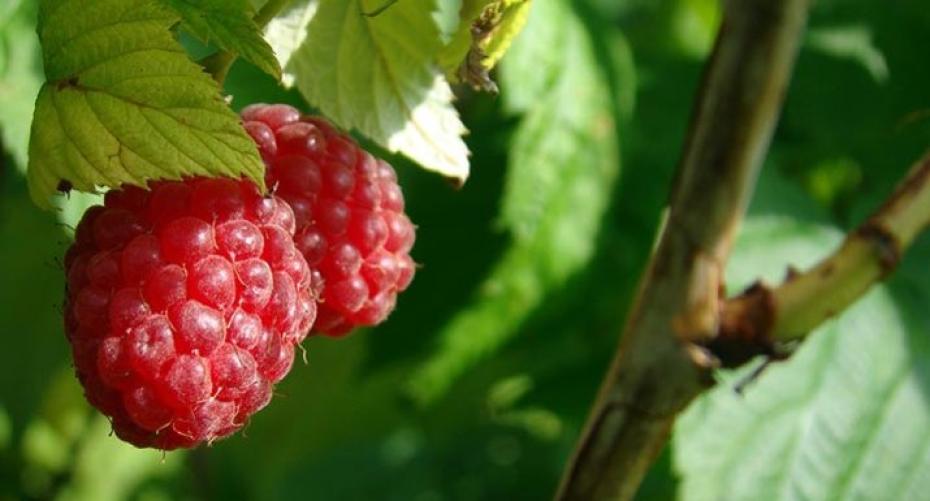Raspberries are easy to grow and cost a fortune in the supermarket
Raspberries are really expensive in the supermarket so it makes sense to grow your own; if space is an issue the short varieties can be grown in a container. Careful choice of varieties can produce a crop of raspberries from early/ mid June to the end of October. They need planting when they are dormant from November to March, and can be bought either as a single plant in a pot or as a bundle of bare-root plants.
They need rich, moisture retentive soil in a sunny sheltered position. They prefer a slightly acidic (pH 5.5 – 6) soil, so if you are gardening with an alkaline soil it would be better to choose the shorter varieties and grow them in a container with ericaceous compost. Don’t plant them on a windy site as they are pollinated by insects which find it difficult to fly in the wind. Make sure the soil is well drained as they cannot tolerate permanently wet conditions; if you are gardening on heavy clay they can be planted in a large container with the bottom cut out. Remove any weeds from the site before planting as the competition will reduce the growth and subsequently the yield of the plant. Mulching with a good thick layer of organic matter after planting will help retain moisture. In early March apply a dressing of blood, fish and bone; if growth is spindly also feed with some pelleted chicken manure.
The varieties which fruit in early and mid-summer (summer fruiting) need cutting back after they have finished fruiting. Just cut out the canes which have borne fruit; cut them out completely to ground level. Select 6 – 8 of the strongest new seasons canes, these will bear fruit the following year, and tie them into the wires, cut off all the remaining new growth.
The autumn fruiting (August - October) raspberries fruit on the canes which they have produced that season so all the canes from these plants must be cut back to ground level in February.
Early fruiting
- ‘Glen Moy’ – a spine-free, heavy cropper with a good flavour; it can sometimes produce a second crop in autumn. This is a compact variety so doesn’t need tying into wires and is suitable for growing in a container.
- ‘Malling Minerva’ – starts fruiting early and continues for about 6 weeks. It is spine free and produces a heavy crop, up to 3.5kg per cane. It is relatively disease and virus resistant.
Mid-season fruiting
- ‘Cascade Delight’ – it has good resistance to root rot so would be the best choice if your soil is slightly wet. It produces large fruits which store for a longer period than normal after being picked.
- ‘Glen Ample’ – this is a spine-free, heavy cropper producing large berries from mid-July.
- ‘Glen Coe’ – this unusual raspberry has deep purple (almost black) berries which are packed with flavour. It has good resistance to verticillium wilt.
- ‘Glen Fyne’ – this is a large, vigorous, spine-free plant which produces sweet berries with a good flavour.
Late fruiting

- ‘All Gold’ – this raspberry has short canes which don’t require tying into wires and is ideal for growing in a container. The yellow, sweet, fragrant berries are produced over a long period.
- ‘Autumn Bliss’ – this is a good reliable favourite producing a good yield of well flavoured berries.
- ‘Autumn Treasure’ – this produces a heavy crop of large fruits on short stems which means that there is no need to tie the canes into wires and is ideal for growing in a container.
- ‘Polka’ – this raspberry is tolerant of poorer soils, is almost spine-free and produces medium to large fragrant berries. It has a long cropping season from mid-July well into October.
For a quick, light summer dessert try Gino D’Acampo’s recipe for Raspberry Mousse:
Blitz 3 ½ oz (100g) fresh raspberries with 1tbsp icing sugar in a food processor and sieve into a bowl.
Whisk together 5 ¼ fl oz (150ml) double cream and 1bsp icing sugar until stiff.
Carefully combine raspberries, cream and 2tbsp chopped pistachio nuts.
Spoon the mixture into a glass and chill.
Before serving decorate with edible flowers, fresh raspberries or mint leaves.
This recipe makes 1 portion.
For more information on any aspect of gardening contact our Outdoor Plant department, browse our blogs or watch the videos on our Youtube channel.




![Kingsbury-bench-05[1].jpg](http://www.hayesgardenworld.co.uk/cdn/shop/files/Kingsbury-bench-05_5B1_5D.jpg?v=1712162737&width=1500)
![Kingsbury-bench-01[1].jpg](http://www.hayesgardenworld.co.uk/cdn/shop/files/Kingsbury-bench-01_5B1_5D.jpg?v=1712161065&width=1500)
![tw17a-4947_0[1].jpg](http://www.hayesgardenworld.co.uk/cdn/shop/files/tw17a-4947_0_5B1_5D.jpg?v=1712161495&width=1500)
![tw17a-4947_tenbury_5ft[1].jpg](http://www.hayesgardenworld.co.uk/cdn/shop/files/tw17a-4947_tenbury_5ft_5B1_5D.jpg?v=1712161172&width=1500)
![tw17a-4952_tenbury_4ft[1].jpg](http://www.hayesgardenworld.co.uk/cdn/shop/files/tw17a-4952_tenbury_4ft_5B1_5D.jpg?v=1712161034&width=1500)
![thumbnail_IMG_1565-kik_2[1].jpg](http://www.hayesgardenworld.co.uk/cdn/shop/files/thumbnail_IMG_1565-kik_2_5B1_5D.jpg?v=1712226536&width=1500)
![thumbnail_IMG_1565-kik_1[3].jpg](http://www.hayesgardenworld.co.uk/cdn/shop/files/thumbnail_IMG_1565-kik_1_5B3_5D.jpg?v=1712159637&width=1500)



![WD-XgESA[1].jpeg](http://www.hayesgardenworld.co.uk/cdn/shop/files/WD-XgESA_5B1_5D.jpg?v=1712159609&width=1500)